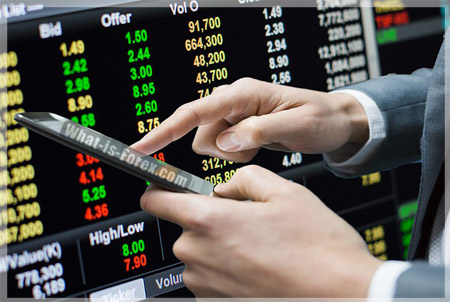🏦 Introduction to Foreign Exchange Trading
Forex, or Foreign Exchange, is a global market where two national currencies are traded against each other. These two currencies form an exchange rate and are known as a Forex pair. For example, the Euro against the US Dollar creates the EURUSD pair, also called the Eurodollar pair.

ℹ️ General Information about Forex Trading
Exchange rates are the focus of investment and speculation. Besides central banks, the major participants in the Forex market include:
- Commercial and investment banks
- Retail traders (common people) via Forex brokers
- Institutional investors (investment firms, hedge funds, etc.)
- Trade companies (importers/exporters) and other companies that are exposed to currency risk
🕒 The Foreign Exchange market operates 24/5, from Monday to Friday.
🌍 Where is Forex Market Situated?
Actually, Forex has no center, it operates as a decentralized electronic network, almost the same way as the World Wide Web. Every buy/sell order is executed according to demand and supply. This electronic infrastructure is called the ECN network (Electronic Communication Network) of Banks.
🔗 Read More: What is Forex?
✅ The Advantages of Forex Trading
The decentralized nature of the Forex market offers several advantages to its participants:
(1) Reliability, fast execution, and trading anonymity through the ECN network
(2) Transparency and equal terms for all orders, regardless of their origin
(3) Exceptional liquidity (Forex daily volumes exceed 5 trillion US dollars)
(4) Low trading costs, especially for highly liquid pairs such as EURUSD, GBPUSD, and USDJPY
(5) 24-hour trading availability (24/5) with access via desktop and mobile devices
💱 Currency Pairs Categorization
As mentioned, Forex currencies are traded in pairs—you buy one currency while simultaneously selling another:
-
The currency you buy is called the Base Currency
-
The currency you sell is called the Quote Currency
Based on their importance and liquidity, Forex pairs are classified into three categories:
(a) Forex Majors — the most liquid and least expensive pairs to trade (EUR/USD, USD/JPY, GBP/USD, USD/CAD, USD/CHF, AUD/USD, NZD/USD)
(b) Forex Minors — popular pairs, but less liquid than majors (e.g., EUR/AUD, GBP/CAD)
(c) Forex Exotics — less popular and more costly to trade (e.g., USD/TRY)
🎯 THE THREE KEY STEPS BEFORE STARTING TRADING FOREX
(1) Define Your Trading Style According to Your Time Frame
You should choose a trading style that matches your risk profile. Before starting to trade Forex, every trader needs to answer four key questions:
(i) How much money are you willing to risk?
(ii) What is your level of experience?
(iii) What are your targeted annual returns?
(iv) What is your time frame, and how much time can you dedicate to Forex trading?
Table: By answering these questions, you can determine the trading style that best suits your individual profile:
|
TRADING STRATEGY |
TIMEFRAME |
EXPERIENCE REQUIRED |
DEDICATED TIME |
RISK |
|
CARRY-TRADING |
A few months to several months |
MEDIUM |
A few hours per month |
LOW |
|
SWING-TRADING |
A couple of days to a couple of weeks |
MEDIUM |
A few hours per week |
MEDIUM |
|
DAY-TRADING |
A couple of hours |
HIGH |
A few hours per day |
HIGH |
|
SCALPING & EA TRADING |
A couple of minutes |
VERY HIGH |
Many hours per day |
VERY HIGH |
(2) Choose the right Forex Broker
Choosing the right Forex broker can make all the difference between winning and losing in the long run. Here are the most important factors, organized into four general categories:
(A) Safety of your Funds
- Forex broker regulation level
- Segregation of funds
- Forex broker headquarters
- Forex broker existence in the market (in years)
- Compensation scheme in case of insolvency
(B) Cost of Trading
- Trading Spreads & Trading Commissions
- Overnight rates (for swing and carry traders)
- Withdrawal or Maintenance Fees
- The existence of a Cash Bonus or of a Trading Rebate
(C) Trading Options
- Forex Asset Index
- Other Financial Instruments (Futures, Options, CFDs on Futures, etc.)
- Allowance of Hedging/Scalping » What is Fx Scalping?
- Deposit and Withdrawal Methods
(D) Level of Technology Provided
- Trading Platforms
- FIX/API
- PAMM/MAM accounts
- Automated Trading (Expert Advisors)
- Mobile Traders
🔗 Learn about the » Forex Rating Formula at TradingCenter
Using our Forex Broker Reviews, you may find information regarding the world’s most popular Forex brokers.
(3) Start with a Demo Account, then move to a Micro-lot Real Trading Account.
Opening and using a demo account allows you to gain experience for free. You can test many aspects of your Forex broker’s trading efficiency, such as spreads, slippage, overnight rates, and more. It costs nothing and is very easy to do. Additionally, a demo account can serve as a tool to measure your trading performance, instead of relying on paper trading.
Forex Lot Sizes
A lot in Forex trading is the standard unit size for any transaction. There are three lot sizes, and if you are a beginner, the micro lot is the best choice for you.
(i) Micro Lot → Suitable for Forex Beginners the size is $1,000 (that means you may open a position worth a couple of US Dollars)
(ii) Mini Lot → Suitable for Advanced Traders, the size is $10,000
(iii) Standard Lot → Suitable for Pro Traders, the size is $100,000
🔗 COMPARE: » Forex Brokers List
■ Introduction to Forex Trading
What-is-Forex.com (c)







